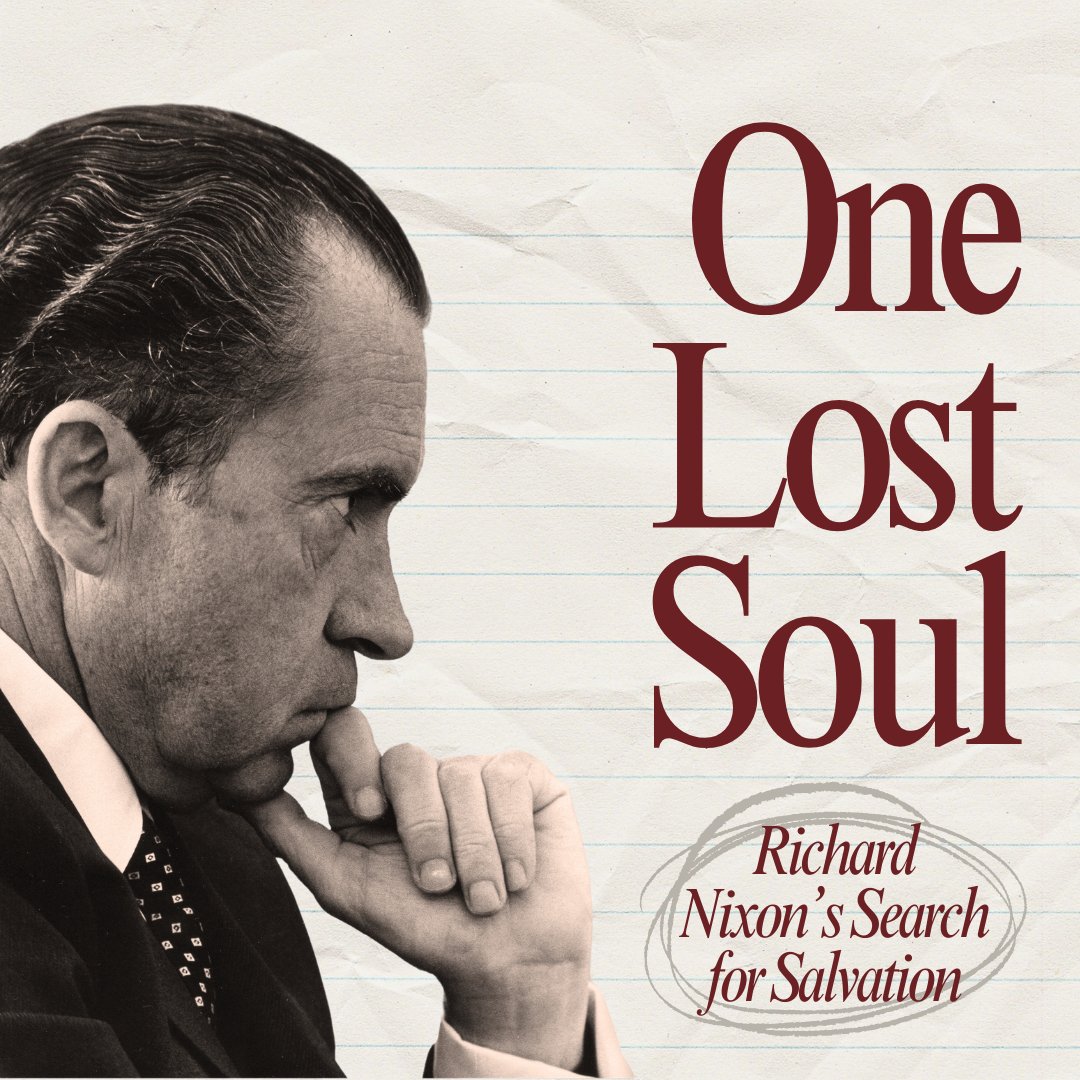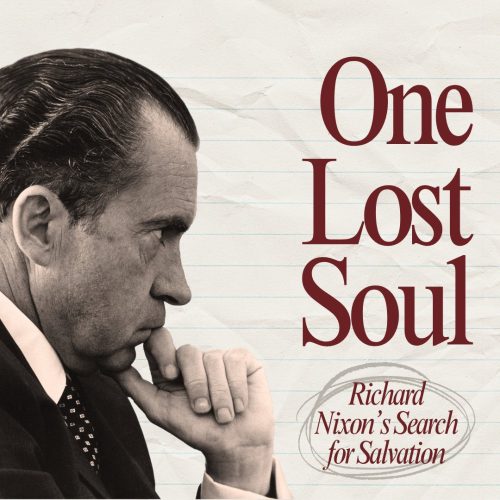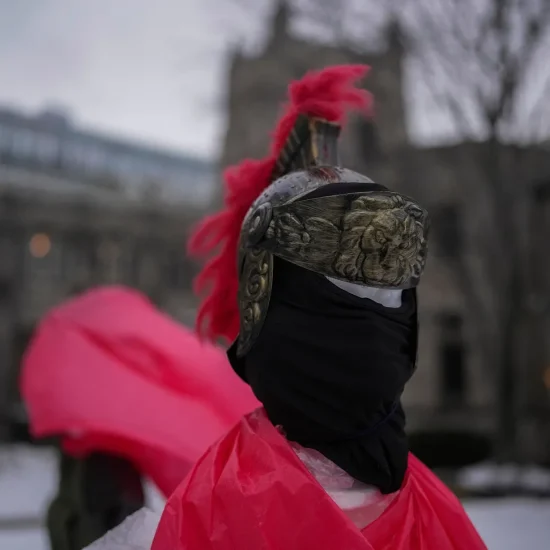

ONE LOST SOUL: Richard Nixon’s Search for Salvation. (Library of Religious Biography). By Daniel Silliman. Grand Rapids, MI: Wm. B. Eerdmans Publishing Company, 2024. 317 pages.
I was just ten years old when I stood alongside the highway with a group of supporters of Richard Nixon’s 1968 campaign for President. I wore my “Nixon’s the One” sash and welcomed Nixon’s motorcade as headed to a rally in Klamath Falls, Oregon. Four years later, now age fourteen, I took on a larger role in the Nixon campaign, which he won in a landslide. I knocked on doors in my neighborhood polling residents about their plans for the upcoming election. Not long after the election, we learned that the President had gotten caught up in a coverup of political dirty tricks undertaken by members of his campaign. That led to his resignation, making him the only United States President to resign from office.

Robert D. Cornwall
Richard Nixon was and is an enigma. He was both a conservative Republican politician and at times a forward-thinking one. He ordered the bombing of Cambodia and made a historic trip to China, which opened up relations with that budding power. In the 1950s he was the point person for the Eisenhower White House on civil rights, and then in 1968 pursued the Southern Strategy that sought to bring segregationists into the party of Lincoln. This set up the political realignment that continues to this day. It’s been fifty years since Richard Nixon resigned from office but he remains an enigma.
In One Lost Soul, which is the latest contribution to the Eerdmans Library of Religious Biography, Daniel Silliman explores Nixon’s life and career with an eye to his religious orientation. The inclusion of Nixon may seem strange at first and yet there is an important religious dimension to his story. The author of this biography, Daniel Silliman, is the news editor at Christianity Today. He holds a doctorate in American studies from Heidelberg University in Germany and has taught at the University of Notre Dame, Valparaiso University, and Milligan University. He has recently signed a contract with Eerdmans to write a biography of P.T. Barnum.
Silliman reminds us that Nixon was by birth and formation a Quaker, which is a historic peace tradition. That formation would seem to run counter to the person who enlisted in the Navy during World War II and pursued the war in Vietnam as President. Silliman writes about how this formation defined his view of religion, the world, and himself. As many know, he was also close friends with Billy Graham and had a friendship with Norman Vincent Peale, both of whom served as informal advisors through the years. In later years Graham would rue the nature of that relationship, but they formed an important partnership that sought to connect the evangelical world with Republican politics.
Silliman’s title reveals something important about Nixon that gets carried through the biography. He points out that Nixon was raised in a rather stern Quaker household, with an angry father, and a cold and distant mother. As a result, Nixon grew up never feeling as if he measured up. We learn that the Nixon family was very religious, attending church with great regularity. However, grace was never a part of his religious formation. Therefore, growing up in a family and faith tradition that demanded perfection, Nixon came to believe that the only way for him to succeed in life was to work harder than anyone else. Success depended on his efforts, often working against great odds. As Silliman points out, Nixon sought salvation of a sort, but he was unable or unwilling to receive God’s grace. Thus, he was a lost soul.
Silliman seeks to unpack that aspect of Nixon’s life, so he doesn’t offer the reader an in-depth biography of Nixon. If you are looking for that you will want to supplement this book with other biographies. Nevertheless, Silliman offers us an intriguing look at Nixon’s life. He spends a significant amount of space on Nixon’s early years — running from birth to college (1913-1933). He titles this opening chapter of the biography “Salvation by Work.” He tells us that Nixon grew up believing that he possessed an “iron butt.” This was his “core truth about himself.” Therefore, “he was a striver. He had a work ethic and drive and everything he ever got, he worked for. Nothing came easy to him, nothing freely given, nothing bestowed by grace. But that didn’t matter” (p. 33). This core truth had religious roots in his Quaker upbringing.
From 1933, we jump to 1948, with a few flashbacks to Nixon’s service in the Navy. It was in 1948 that the California Republican Party recruited him to run for Congress. This chapter, titled “Cold War Christian,” reveals how this nominal Quaker became an anti-Communist fighter. He believed that he was called to participate in a holy venture. As for his theology, Silliman points out that like many Mainline Protestants, he “sought to remove the supernatural and mythological elements of the Christian faith, putting their emphasis on morality and good works.” While he could have joined any number of Mainline churches, he maintained his connection with his hometown Quaker church in East Whittier, California. Otherwise, he largely ignored religious things. What mattered was fighting communism. This led him to join the House Unamerican Activities Committee, which in turn led to the prosecution of State Department employee Alger Hiss for treason. He didn’t stay in the House of Representatives for very long, because he translated his political efforts in the House into his election to the United States Senate in 1950, representing California.
Not long after his ascendancy to the Senate, he was asked to join the Eisenhower campaign as Dwight Eisenhower’s Vice-Presidential candidate. Although Eisenhower won the election, the campaign of 1952 was not a happy time for Nixon. Thus Chapter 3 is titled “The Checkers Speech.” This is the famous speech given in 1952 to save his candidacy after word leaked out that supporters had set up a fund to support his political activities as a Senator. Checkers was a dog given to the Nixon family, who served as the defense for Nixon’s candidacy. It worked, even though Eisenhower essentially left Nixon hanging in the wind until the speech cleared the way for him to continue. Thus, he experienced a moment of political salvation. We learn that his relationship with Eisenhower was never close and that the President may have preferred someone else as his governing partner. Nevertheless, Nixon, true to his core truth, worked hard on behalf of the administration, including serving as the point man on the administration’s civil rights efforts, which led to a partnership with Martin Luther King.
The next key moment was the 1960 election that pitted the Vice President against John F. Kennedy, the popular Roman Catholic Senator from Massachusetts. In Chapter 4, titled “The Religion Issue,” Silliman focuses on one of the key elements of the 1960 election. That was Kennedy’s Roman Catholicism. His advisors, including Graham and Peale, wanted him to use this against Kennedy, but Nixon had an aversion to focusing on religion, including Kennedy’s Catholicism. That aversion to discussing religion may have cost him votes because Kennedy highlighted religious tolerance, something Nixon embraced but didn’t address in the campaign. This allowed Kennedy to draw upon Catholic loyalty to achieve enough of a margin to win. When the election was over, Nixon perceived himself to be a loser. So, he returned to California and thought about what it meant to lose.
Nixon didn’t stay out of politics for long. In 1962 he pursued election to the governorship of California, running against the incumbent Pat Brown (father of Jerry Brown). Once again, he lost. Deciding it was time to give up his political ambitions, he moved to New York City and joined a law firm. He was rather successful at it. During this period, he attended with some regularity the Marble Collegiate Church, where Norman Vincent Peale was preaching his message about the power of positive thinking. Chapter 5 addresses the next phase of Nixon’s political life. He once again caught the political bug and decided to once again pursue the presidency. That was 1968. Silliman titles the chapter dealing with this period “The Highest Mandate.” The year 1968 was a time of turmoil. The nation was bogged down with the Vietnam War raging, which led President Lyndon Johnson to drop out of the presidential race on the Democratic side. It was also the year that Martin Luther King and Robert Kennedy were assassinated. While Nixon had a solid Civil Rights record and reputation, he chose to pursue a law-and-order campaign that included the famed Southern Strategy. He chose to appeal to Southern segregationists, which ended up turning the South Republican. He won, beating Johnson’s Vice President, Hubert Humphry. This time, he won. He had worked hard and achieved the prize. Silliman writes: “He was fifty-five years old. He was going to be president. He was not a loser” (p. 153).
Most Presidents before him joined a church upon entering the White House. Nixon broke that mold. Silliman devotes Chapter 6 to “Church in the White House” (1969). This chapter is an important contribution to the way religion functions in the White House. President Eisenhower, who grew up a Jehovah’s Witness, decided to join the Presbyterian Church. Kennedy was Catholic and Johnson was a member of the Christian Churches (Disciples of Christ). Nixon could have joined a Quaker church in Washington or attended any number of local churches including the Episcopal Church that stood near the White House, the so-called Church of the Presidents. Nixon chose none of those options but instead opted to create a church in the White House. This is a fascinating story that may not be well known to contemporary audiences. One reason he chose this route was that he didn’t want to put himself in a position where he could be the target of a sermon from a preacher eager to criticize him, as had happened to President Johnson when he attended National City Christian Church. Besides, Nixon was something of a control freak and by creating a church in the White House he got to control the service. He chose the preachers, in consultation with Graham and others, the hymns, and those who attended. By and large, the preachers left him alone, just as he hoped. It wasn’t just a Christian service because he invited Rabbis to preach as well. Though the Rabbi had to lead the congregation in the doxology. After Watergate broke, the services ended, and Nixon prayed alone.
Silliman titles Chapter 7 “Peace, Peace, But There is No Peace.” This chapter covers the period 1969 to 1973, the years of the Nixon presidency. Here Silliman takes up the primary issues of the day, including the war in Vietnam and Nixon’s decision to bomb Cambodia, where the North Vietnamese and Vietcong had created bases, even though Cambodia was not part of the war. He also ordered the bombing of Hanoi. This led to problems with his Quaker church relationships. While his home church stood by him, many Quakers were unhappy and sought to have him excommunicated (so to speak). They failed because of the loose connectionalism of Quakerism, but Nixon was faced with the challenge of his faith tradition. Interestingly, he tried to portray himself as a pacifist seeking to bring peace to the world by winning the war in Vietnam.
The war wasn’t the only area of concern. Nixon wanted “To Be a Great Man” (Chapter 8). The key element of Nixon’s presidency was his groundbreaking trip to China in 1972. China had closed itself off from the world, and yet an opportunity arose for Nixon, the anti-Communist, to make history by going to China and opening up relations with China. When we add this to other aspects of Nixon’s presidency, we discover that he was fairly progressive, especially in contrast to the contemporary Republican Party. He established the EPA, sought to control inflation through price controls (Kamala Harris has been called a communist for advocating something less than that), and even pursued a health care plan that would have gone further than the Affordable Care Act. But, the trip to China was the key to success. This is a most interesting and enlightening chapter, especially since we may have forgotten how important this trip was to future relations with China. Nevertheless, he never felt he got the credit he deserved for this effort.
Richard Nixon might have been among the greatest of American Presidents if not for a dark side to his personality. It was rooted in his insecurities and fears of how others perceived him. That insecurity led in 1974 to his resignation from the Presidency after it was discovered that he had authorized a coverup of the failed attempt to bug the Democratic Party Headquarters. In Chapter 9, “The Final Judgment,” Silliman explores the downfall of the President, a downfall that was abetted by his desire to record his life for posterity. His felt need to keep a record of his presidency involved the bugging of his White House, such that conversations with his aides about the need to cover up the burglary were present on tapes that Congress got a hold of. He resigned after he learned from leading Republican Senators that he had lost the Senate. Therefore, not only would he be impeached, but he would also be removed from office. The chapter ends with Nixon asking Henry Kissinger to kneel with him in the Lincoln Bedroom to pray.
The final chapter (Chapter 10) is titled “Redeeming Himself.” In this chapter, Silliman tells the story of Nixon’s life after he resigned from office. This chapter covers the period from 1974 to Nixon’s death in 1994. Having to resign in disgrace threw Nixon into a state of depression. He even contemplated suicide. Given time, however, Nixon pursued redemption, but not with God, with the nation. Silliman writes: “Losing everything can lead some people to finally, fully throw themselves on divine mercy. When there’s nothing left that you can claim as merit, nothing to cite as convincing evidence of your worth, you just have to ask God to love you.” That is not the path Nixon chose. Silliman writes “In the days after his resignation, he dwelled in self-pity and despair. The humiliation seemed as if it would crush him. Then, deep inside, he found a reservoir of anger and resentment. It gave him strength. He would go on, he said, out of spite.” He would show his enemies who he truly was and tell them to go to hell (p. 275). True to his core, he went to work. He wrote books, gave speeches, and sought to reenter the political sphere even if he would never again hold office. What he could become was a senior statesman. As for God, Nixon wasn’t going to ask God to accept him without one plea. “He would do it on his own.” So, he did. Silliman ends the book with this description of Nixon’s death: “A little after 9 p.m. on April 22, 1994, Richard Nixon, the boy from Yorba Linda, the man who disgraced the presidency, passed from this life into the arms of the God who loved him, even though he never really believed that was true.” (p. 292).
It’s been thirty years since Richard Nixon passed from this world. A generation or two have arisen who knew not Richard Nixon. These generations may have heard of him, but not truly know who he was. Silliman helps us better understand Nixon’s enigmatic story. The truth is, Richard Nixon left behind a rather mixed legacy. He accomplished great things and overcame great odds. That includes having to deal with cold and distant parents and a religious formation that focuses on hard work and not grace. It was that message of hard work that Nixon embraced and embodied, but the lack of grace also contributed to his sense of inadequacy and search for greatness. He believed in religious tolerance and at least early on embraced the Civil Rights Movement. Yet, in pursuit of victory, he aligned himself with segregationists and a Southern Strategy that continues to make itself felt in the Republican Party of today. He saw himself as a pacifist but pursued a war with fury (all in the name of making peace in the world). He was friends with Billy Graham but could be vulgar and spiteful. His Quaker origins helped form him as a person and yet religion played a very small part in his own life story. If he was going to be redeemed, he would have to do it himself because he didn’t believe God truly loved him. All in all, this makes for a rather interesting religious biography! That is what Daniel Silliman offers in One Lost Soul: Richard Nixon’s Search for Salvation.
This review originally appeared on BobCornwall.com.
Robert D. Cornwall is an ordained minister in the Christian Church (Disciples of Christ). Now retired from his ministry at Central Woodward Christian Church (Disciples of Christ) of Troy, Michigan, he serves as Minister-at-Large in Troy. He holds a Ph.D. in Historical Theology from Fuller Theological Seminary and is the author of numerous books including his latest “Second Thoughts about the Second Coming: Understanding the End Times, Our Future, and Christian Hope” coauthored with Ronald J. Allen. His blog Ponderings on a Faith Journey can be found at www.bobcornwall.com.






